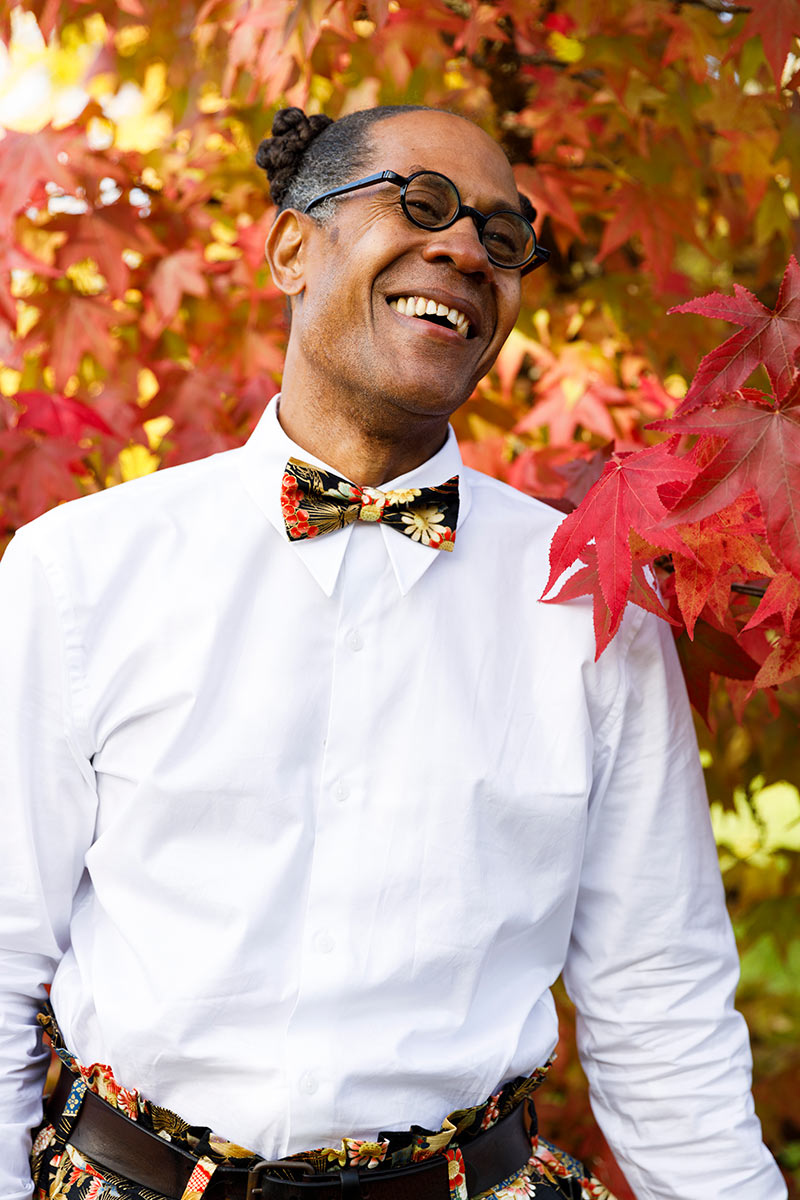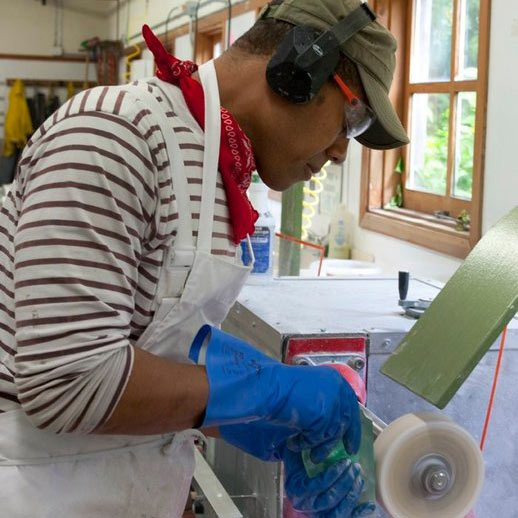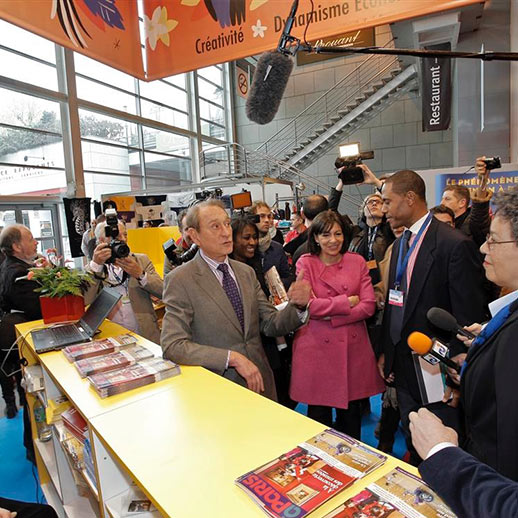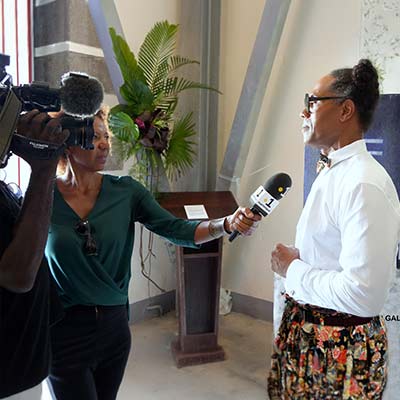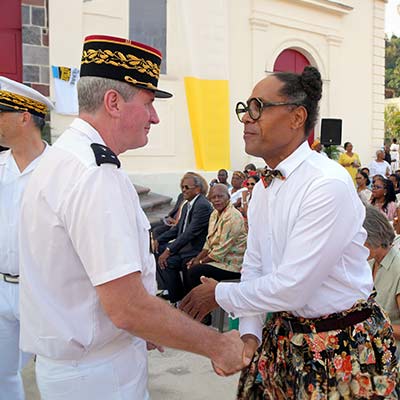Itinerary
There is nothing linear, premeditated or planned about Régis Granville’s journey. It is nourished by encounters, daydreams, childhood memories, the emotions of the adolescent and adult that he is, his wonder in the face of nature, in the face of human beings rich in experiences, of knowledge, of know-how, of knowing how to be.
At Régis Granville, everything follows one another, intersects, intersects, overlaps without apparent logic; yet the constancy of his progress, the diversity in his plastic research nourished by a humanism and a philosophical reflection dear to the artist, constitute the springs of an artistic proposition which is now solid and total.
“My sources of inspiration are multiple: a gesture, a look, an expression, listening to people of all ages, cuisine from here and elsewhere, a light, a landscape, a symbol, everything that comes resonated with me at some point; my family mix, my Martinican origins, the values received from my parents and my maternal grandparents who taught me respect for others…” – Régis Granville
A happy childhood and adolescence
From a young age, Régis marveled at the sight of the stained glass windows of the church of François, his hometown in Martinique. He devotes himself to drawing, painting, piano and dancing. These different artistic activities find an echo in his adult life path.
As a child, Régis took piano lessons with Marius Cultier, an international jazz musician from Martinique.
From the ages of 11 to 17, Régis trained in contemporary dance and modern jazz at SERMAC in Fort de France, then at Paris Center Clichy where he was spotted by the choreographer Nelson.
Durant son jeune âge à 1991, Régis est engagé dans différentes troupes et ballets (Ballet Love Nelson / The Alvin Ailey American Dance Theater, en stage / Sous la direction du chorégraphe-danseur Alfred Alerte du Ballet de Christiane Blaise / Georges Paisley, chorégraphe-danseur indépendant). Régis est rappelé en 2005 par la chorégraphe Suisse Kareen, et la chorégraphe-danseuse Monica Frasson pour une dernière prestation à Cordoba, en Argentine.
Rencontre avec les arts plastiques – les arts visuels
In 1986 during a student evening in Paris, then in 1987 at the bedside of a hospitalized friend Sabine Ouamba, Régis met the painter Martine NZE. The love of art naturally brings them together. This contact was decisive, with Régis becoming his student in 1987. Martine periodically taught him the keys to abstract art until 1997. That year, Martine organized a group exhibition, and gave Régis the opportunity to present his works. In 2012, always keen to improve his knowledge, Régis perfected his technique of oil and acrylic painting on canvas in the fine arts workshops of the City of Paris.
An adventurous artist
From 1988 to 1992, Régis simultaneously undertook university studies in London in international tourism, hospitality and the English language, supplemented by a language stay in Spain. During this period, Régis financed his studies thanks to “odd jobs”, notably that of reception and catering service within the establishment “The Cottons Art Gallery Jazz Restaurant”. The director, Michelle Bartlett, offers Régis the opportunity to exhibit his paintings in the gallery.
Always in search of new encounters, new cultures, Régis traveled the world between 1998 and 2008. Photography appears implicitly in his artistic work, a practice that he experiments with depending on the moment.
From 2002 to 2008, Régis lived more specifically in Argentina, and worked on an ecological hotel complex project. He also organizes tourist stays and explores South America.
The discovery of glass
En 2008, Régis décide d’étudier le verre, ému par ses souvenirs d’enfance et par le travail des maîtres verriers, observés en 1997 lors d’un voyage à Venise, sur l’île de Murano en Italie. Il s’inscrit à l’université du verre de Sars-Poteries dans le nord de la France afin d’apprendre les différentes techniques de travail du verre (il y rencontre Olivier Juteau et le couple Martine et Jacky Perrin). Sa formation est validée en 2010, après avoir effectué un stage avec l’artiste verrier de renom, Udo Zembok à Colmar, ce qui l’oriente sur la technique du verre en multicouche « fusing » par inclusion de pigments, spécialité que Régis affectionne particulièrement. La collaboration de Régis avec Udo, débutée en 2009, se poursuit jusqu’en 2013 à Camporosso, Italie.
Toutefois la passion de Régis pour le verre ne s’arrête pas au fusing. Entre 2010 et 2012, Régis se familiarise également avec d’autres techniques, comme le travail de la pâte de verre, le thermoformage, le verre soufflé, et la peinture sur verre ; à Pilchuck Glass School campus universitaire à Longwood, Seattle (où il rencontre Ki-ra Kim, célèbre professeur à l’université de Séoul en Corée du Sud et son assistante Kay Hyewook, ainsi que Mark Salsbury de Saint-Louis – USA), puis au lycée Loucas de Néhou à Paris.
En 2013, cette passion trouve toute son expression dans la publication de « QÛX one, naissance d’une passion », un livre d’art publié à 400 examplaires en trois langues (français, japonais, anglais), aux éditions Lelivredart à Paris.
Un artiste touche à tout
Dans la continuité du travail du verre, il faut également évoquer l’intérêt de l’artiste pour la sculpture sur pierre, métal et bois, qu’il expérimente en autodidacte.
In 2015, Régis met Felix Rohner and Sabrina Schärer, inventors of the Hang Gubal, an instrument with a soothing sound. Echoing his early taste for music, Régis added a new string to his bow, by learning the practice of this instrument from the Swiss couple.
De 2015 à 2018, Régis s’investit dans son projet DMUM « Dessine-Moi Un Mouton », une œuvre itinérante. L’œuvre de Régis est une invitation poétique et artistique à la découverte de notre intérieur dans les pas du Petit Prince et sur les traces d’Antoine de Saint-Exupéry, dont la vision et l’objectif sont de reconnecter l’être humain à sa créativité, à son intuition, à son cœur d’enfant (http://www.dmum.art/bande-annonce-teaser/). Par la création de l’association DMUM « Dessine-Moi Un Monde », Régis invite ses amis artistes multidisciplinaires à le rejoindre.
In 2021, following the lifting of health restrictions linked to the pandemic, Régis transformed his apartment into a “Home Sweet Gallery” and exhibited his creations there.
Back to basics
Since 2020, after leading a visual art painting workshop punctuated by the exhibition of his students' creations, in Pondicherry in India, Régis returns to his first great love, painting, with a mind teeming with projects. Since September 2023, and for three years, Régis has been taking large-format abstract painting classes at the fine arts workshops in Paris. With a workshop in Tuscany Italy in 2022 and 2023, Régis creates new creations of oil and acrylic paintings on canvas, with a view to his first exhibition in Martinique from February to March 2024 within the Scène Nationale Tropiques Atrium in Strong of France.
The portrait of Régis would remain incomplete by obscuring his spirituality which he developed through his practice of Nichiren Buddhism, a Japanese reforming monk from the 13th century, and which occupies an essential place in his daily life. Régis draws from it all the vital energy necessary for the expression of his creativity which is so visible in all of his work.
His career makes Régis GRANVILLE a passionate, inspired, instinctive and unclassifiable artist.

